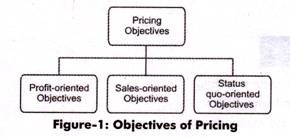Pricing can be defined as a process of determining the value that is received by an organization in exchange of its products or services.
It acts as a crucial element of generating revenue for an organization.
Therefore, the pricing decisions of an organization have a direct impact on its success.
The price of a product is influenced by a number of factors, such as manufacturing cost, competition, market conditions, and quality of the product. An organization, while setting the prices of its products, needs to ensure that prices must cover costs incurred for producing products and profit margins. If the price of a product does not cover costs, then financial resources of the organization would exhaust, which would ultimately result in the failure of business.
ADVERTISEMENTS:
An organization uses a number of methods and strategies to determine the prices of its products. In economic terms, an efficient pricing strategy is the one that aims at gaining consumer surplus to the producer. The pricing strategy of an organization should be realistic, flexible, and profitable.
Moreover, it should be focused on achieving the financial goals of an organization. Some of the most common pricing strategies used by an organization include differential pricing, promotional pricing, product line pricing, and psychological pricing.
Concept of Product Pricing:
Setting prices as per the level where marginal revenue is equal to marginal cost is called marginality rule. However, there is evidence produced by some researchers that most of the organizations do not follow marginality rules rather they follow different pricing methods and strategies based on different market conditions. Pricing decisions play an important role in an organization since they help in generating revenue.
Pricing contributes to the success or failure of the organization’s marketing strategy. Price is also called a demand regulator. Setting the prices involves a deep understanding of factors that affect the marketing environment. Every organization sets the prices of its products for fulfilling various objectives.
Types of Pricing Objectives
Figure-1 shows the three types of pricing objectives:
Let us discuss the three types of pricing objectives (as shown in Figure-1) in brief:
i. Profit-oriented Objectives:
Include the following objectives:
ADVERTISEMENTS:
a. Maximizing Profit:
Implies that prices are set in such a way that they help in achieving maximum profit. According to Stanton, Etzel and Walker, “The pricing objective of making as much money as possible is probably followed more than any other goal.” Profit maximization is more beneficial in the long run as compared to short run. For instance, an organization selling a new product tries to build a customer base by selling the product at low prices in the short run. This helps the organization to gain profit in the long run by winning loyal customers.
b. Achieving a Target Return:
Refers to earn an adequate rate of return on the investment done by an organization in manufacturing a product. The main focus of marketers is on maintaining a specific return on sales or investment. This is done by adding extra cost to the product for earning a desired profit.
ii. Sales-oriented Objectives:
Include the following objectives:
a. Increasing the sales volume:
Implies sales expansion by giving discounts to customers. In the short run, an organization might be ready to bear losses by reducing the prices to increase the sales volume. For instance the hotel industry faces low demand during off–season; therefore, it prefers to decrease its prices and offers discounts to increase sales.
b. Increasing or maintaining market share:
ADVERTISEMENTS:
Plays a crucial role in the success of an organization. The organization tries to gain market share by lowering down the prices as compared to its competitors.
iii. Status quo-oriented Objectives:
Includes the following objectives:
a. Stabilizing the Prices:
ADVERTISEMENTS:
Prevents price wars between competitors. The prices are stabilized in those industries where product is standardized in nature. The stabilization of the prices helps in maintaining the demand and reducing competitive threats.
b. Meeting the Competition:
Implies that the changes made in the price of a product help an organization to gain competitive advantage. Sometimes, the organization also tries to neutralize competitive pressures by price movement.
c. Determining prices according to consumer’s paying capacity:
ADVERTISEMENTS:
Implies that the purchasing power of the consumers should be taken into consideration while setting prices. The sales of an organization depend entirely upon the purchasing power of consumers.
An organization also adopts pricing objectives to promote developmental activities in the society. For instance, an organization may reduce the prices of a product for the low-income sections of the society. Thus, the pricing objectives play a significant role in the overall growth of the organization.
